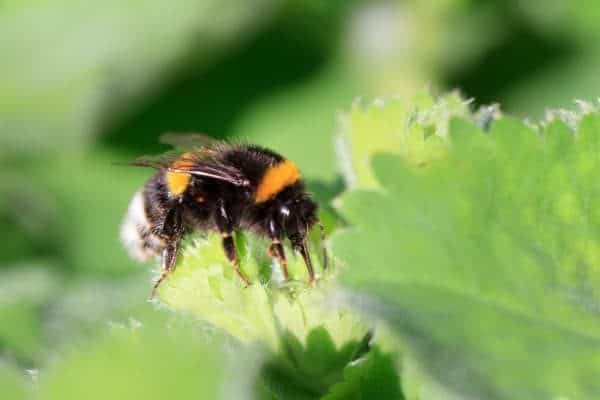
With so many different species of bees, one can begin to wonder if all bees live and behave similarly. While you may pass by a beehive and assume all bees live in hives, you might be surprised to know this is not the case. In fact, 90% of the world’s bee population is actually made up of lone-wolf bees called ‘solitary bees.’
So… Do bumblebees live alone or in colonies? Bumblebees are social insects and live in colonies. Their nests are typically located underground in holes or nests formed by other insects or animals. A bumblebee colony holds anywhere from 50 to 500 bumblebees.
Bumblebees are a singular type of bee native to North America, instrumental in pollination and in need of some love from their local communities to ensure their continued survival.
Are Bumblebees Social or Solitary Bees?
There are two kinds of bees. Social and solitary. Bumblebees fall into the social category as they form colonies and commune with other bumblebees. They live with 50-500 other bees and serve their queen bee. In serving the queen bee, worker bumblebees gather food for the queen and care for her developing larvae.
Where do they Prefer to Build their Colonies?
Bumblebees prefer to build their social colonies in locations closer to the ground (in fact, many of their nests can be found underground.) Many people find bumblebee nests under their wooden decks or porches, or sometimes in a pile of grass clippings in the yard.
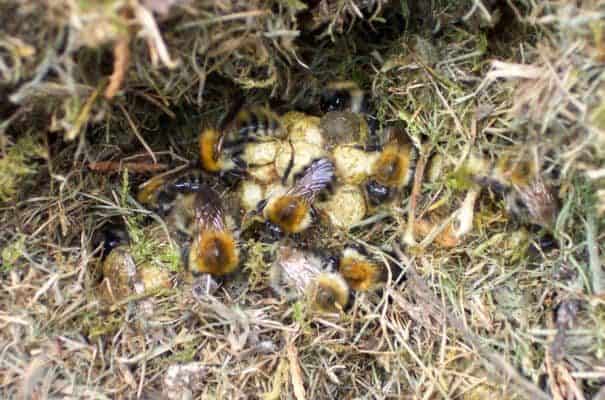
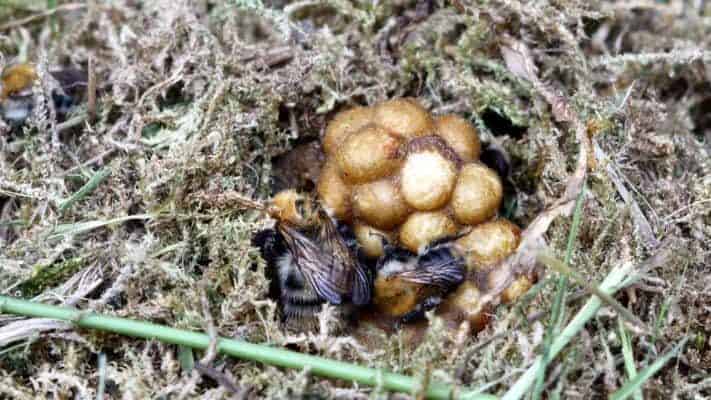
In nature, bumblebees build their nests out of many things! They are excellent at taking advantage of pre-existing holes, nooks, and crannies, rather than building their own nests.
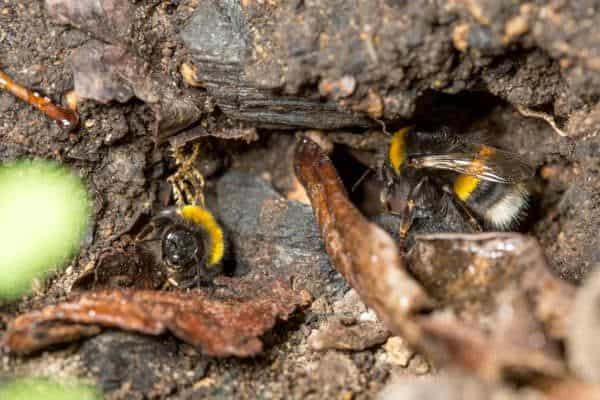
Why not build their own nests? Well, bumblebees have the especially important job of pollinating to attend to…so why waste time on building a shelter if they can refurbish an already existing home?
Other common nest locals include tree hollows, abandoned bird nests, leafy piles, and abandoned rodent dens.
Do Bumblebees Hibernate?
Only one type of bumblebee hibernates, and this is the queen bee! The rest of the worker bees and male (drone) bees die off before the winter, leaving the mated queen bee to hibernate in her underground nest until spring.
Do Bumblebees Produce Honey?
Bumblebees make some honey (or the nectar that becomes honey once water is removed). But whether you call it nectar or honey, they do not make enough for human consumption. Despite their poor honey yield, they are excellent pollinators. Bumblebees help to pollinate berries and vegetables like peppers and hothouse tomatoes.
In fact, there is an entire business dedicated to trading bumblebees to utilize their excellent pollinating skills to achieve flourishing fruit and veggie harvests!
What Do Bumblebees Look Like?
There are over 255 different species of bumblebees! They come in many different sizes, though, typically the largest member of each species is the queen bee.
It can be difficult to distinguish bumblebees from other bee species. Bumblebees are large, fuzzy, and have short little wings that beat extremely fast for their size. For this reason, it has been said bumblebees defy the logic of aerodynamics since their tiny wings should not be able to carry their larger body size.
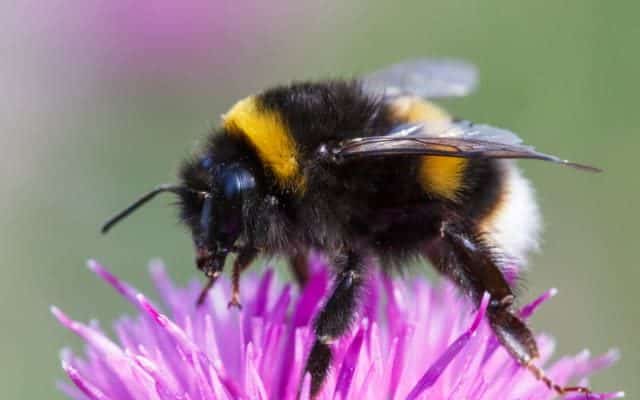
Scientists discovered that bumblebees flit their wings in a back and forth motion, as opposed to up and down. This might account for their aerodynamics. We have a detailed article you might like to check out, with a fascinating super slow-motion video of how bees fly.
Bumblebees are larger than honeybees and are often seen lazily drifting from flower to flower. Some can almost look a little intoxicated. Honey bees, on the other hand, have a sharper, sleeker look to them, and fly with more speed and purpose.
What Makes Bumblebees Such Great Pollinators?
There are many types of pollinators in the world. Birds, bats, and butterflies for example. But bees are without a doubt the most crucial and important pollinators in most ecosystems around the world.
Bumblebees provide a singular pollinating service called ‘buzz pollination.’ Buzz pollination is when the bumblebees’ oscillating wings make the flowers vibrate, causing the flowers to release the pollen. This vibration occurs because a bumblebee’s wings beat 130+ times per second. The result of this buzz pollination means plentiful fruit and vegetable crops.
Another reason that bumblebees are excellent pollinators is due to their heat generation. The size of a bumblebee allows them to generate a precise amount of heat necessary for them to fly early and late in the day. Additionally, their unique size and heat generation allows them to fly into cooler, higher altitudes than honeybees.
Bumblebees are especially hairy. This means more pollen sticks to their furry little bodies. As they move from flower to flower, up to 6000 per day, the pollen is transferred helping maintain genetic diversity among plants of the same species.
Are Bumblebees Facing Extinction?
Bumblebees are considered an endangered species. Many species of bees have experienced adverse effects from urbanization. Bumblebees face a multitude of threats: loss of habitat, competition with other bees (like honeybees), bee diseases, pesticides, and some will say climate change.
In North America, about 1/3 of the 50 different Bumblebee species are declining in population. There are similarly reported drops in bee populations in Europe, Asia, and South America as well. If, bumblebees are becoming an endangered species. This is problematic for many reasons.
Firstly, because the bumblebee is a unique bee, native to North America. It would be a tragic loss to lose the bumblebee to extinction, for scientific reasons. Secondly, the bumble is instrumental in pollination. For bumblebee species to become extinct would mean dire consequences for other life on this planet.
Two-thirds of the globe’s crops depend on bees and other such pollinators to transfer pollen to plants, crucial in continuing crop growth. If a bumblebee’s unique pollination skills can increase food surplus, then the lack of bumblebees would decrease that supply.
Undoubtedly, this would lead to a significant drop in fruit and vegetable yields, meaning less food for humans and animals in the ‘bumblebee extinction’ regions.
How Can I Help Bumblebees Thrive?
While urbanization is certainly a large contributor to habitat loss when it comes to bumblebees, there is good news: you can create habitat for bees anywhere. Even if you live in an apartment in a large city, there is opportunity to create a new habitat for them.
Here are some tips on things you can do to help these talented pollinators thrive:
1. Plant Native Plants for Bumblebees
Providing nectar for food and pollen for protein is an excellent way to help your local bumblebees. From early spring through late fall, bees need food to fuel them to pollinate! For this reason, they need lots of delicious and nutritious nectar to eat. They also need a variety of pollen-producing flowers so that food will continue to be available throughout the year.
The best kind of plants to provide for your local bumblebees are native plants. You can find a list of native plants through the National Wildlife Federation. Why native plants? Native plants have ingenuously evolved alongside the bumblebee. This means that native plants are more capable than non-native plants in supplying the EXACT kind of sustenance and pollens a bumblebee needs to thrive.
2. Build or Find Nests
One of the big parts of habitat loss that adversely affects bumblebees is losing access to their nesting opportunities. As we mentioned earlier, bumblebees tend to nest underground. These nests are typically created by other insects or animals, and then the bumblebees commandeer them.
Bumblebees will however, nest above ground when necessary. They will often find homes in tree cavities (like holes in a tree, or a hollowed-out log), old bird nests, and cracks between large rocks or boulders.
If you would like to help your local bumblebees find homes in your area, you can provide them with easy-to-find nests. Things like unoccupied birdhouses, or handmade nests are excellent options!
Below is a helpful tutorial explaining step by step how you can build your own bumblebee house.
Do Away with Pesticides
If you have a say in what is sprayed around your yard or neighborhood, We urge you to eliminate the presence of pesticides on plants. Insecticides and herbicides are no good.
The worst of all are neonicotinoids. (sometimes known as neonics) These types of pesticides seep into the vascular system of plants, which then poison the poor bumblebees who feed on these plants’ nectar. This is then made worse, as they then disperse their contaminated pollen to other plants, posing a risk to other bees.
The Solitary Bee
90% of the world’s bee population are solitary bees. They are often female bees who nest alone in the ground, in cracks in walls, or in wooden cavities. They source nectar and pollen for themselves and their own offspring.
Solitary bee species come in a myriad of shapes, sizes, and colors. Some of the most common solitary bees are carpenter bees, mason bees, digger bees, plasterer bees, and sweat bees.
The Wrap Up
The social, fluffy, aerodynamic defying bumblebee is a scientific marvel. Not only that, but bumblebees are instrumental to the survival of crops all around the world. If 2/3 of the world’s crops are dependent on pollinators, the loss of bumblebee species would be devastating.
The more you learn about bumblebees, the more passionate you will feel about ensuring their survival. We hope you will help your local bumbles by planting nutritious and pollen heavy native plants, supplying easy to find nesting opportunities and eliminating pesticides in your garden.
